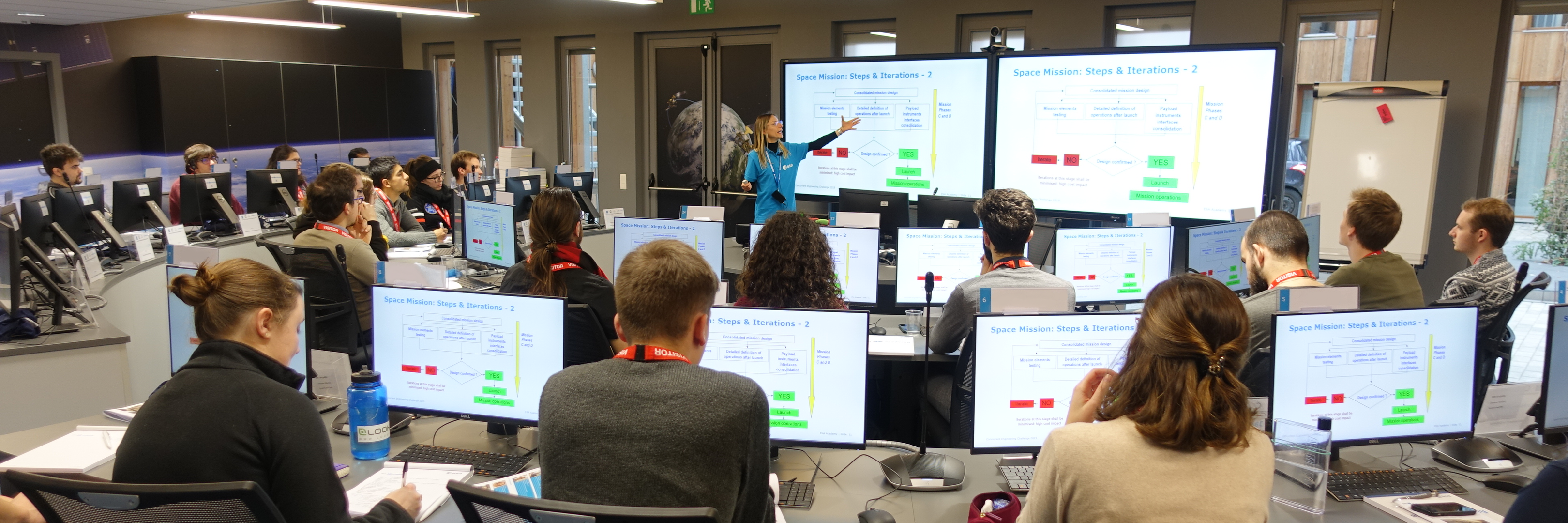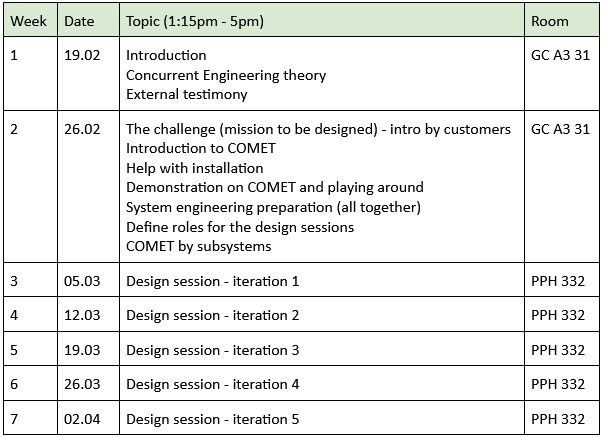¶ ENG-411 Concurrent Engineering of Space Missions
Welcome to the EPFL class on concurrent engineering for space mission and systems. This course was first held in Spring 2023 as part of the EPFL Minor in Space Technologies, after an ESA concurrent engineering challenge (CEC) took place at EPFL in 2022.
Here you will find a basic description of the course together with all the material from and resources used during the class.
Important! Availability during the design sessions is required to fulfill the course requirements.
EPFL information about the course and how to register can also be found here.

Credit: ESA
¶ Basic info
Credits: 2
Semester: Spring
Language: English
Exam: Oral
Workload: 66 h
Structure: 7 first weeks of the semester
Lecture: 8h total over 2 afternoons
Practical work: 54h (incl. 5 design sessions, debriefs, final presentation, time for writing the report)
Number of positions: max 15, min 8.
¶ Summary
The main objective of this course is to teach the students the fundamentals of concurrent engineering for space missions and systems. The course is built around a similar framework to that of the European Space Agency’s (ESA) Concurrent Engineering Challenge.
Students are teamed up to design a space mission together, using the tools and process of Concurrent Engineering. During the course they will be at all times supported by experts from eSpace. This is a cooperative challenge, meaning team members will share progress at the end of every day and collaborate to design a mission or system. Course ends with a final presentation of the mission/system designed by the team. By the end of the course students shall become familiar with the foundation, benefits, and application of concurrent engineering practices when applied to solving complex engineering problems.
¶ Outline
¶ Introduction
- What is concurrent engineering?
- Introduction to common concurrent engineering practices and tools.
- Target mission design: mission overview, science objectives, and high-level requirements.
¶ Practical engineering of a space mission
- Primer on the space environment and spacecraft subsystems. Students form a team and are individually assigned to a given subsystem based on their competencies and interests. The involved disciplines include: structures and mechanisms, configuration, power, thermal, AOCS, propulsion, trajectory analysis, communication and data handling, sustainability, and systems engineering.
¶ Concurrent and Systems Engineering techniques in action
- Real-time concurrent engineering processes, including: mission phases and modes definition, identification and resolution of key design trade-offs; design budgets; product tree; design iterations; preliminary subsystem design; trades between subsystems.
¶ Engineering teamwork
- Structured, intensive collaboration within and between engineering disciplines to rapidly design, in a realistic environment with tooling. Leadership and interpersonal skills, including presentations to peers and expert review, and their impact on design process success.
¶ Learning Prerequisites
¶ Required courses
- Spacecraft design and system engineering (EE-584) with Emmanuelle David
- Space mission design and operations (EE-585) with Thibault Kuntzer
¶ Recommended courses
- Systems engineering (MICRO-405) with Prof. Gilles Feusier, Prof. Yves Bellouard, Prof. Christophe Moser, and Prof. Volker Gass (if given)
Some practical engineering team project experience is also recommended.
¶ Learning Outcomes
By the end of the course, the student must be able to:
- Perform concurrent engineering
- Coordinate with other students to design a coherent space mission
- Design a spacecraft sub system and understand its impact on system design
- Create a new mission in the frame of rapid, real time collaborative design
- Negotiate sub system tradeoffs and communicate key concerns to system levels
¶ Transversal skills
- Write a scientific or technical report.
- Access and evaluate appropriate sources of information.
- Set objectives and design an action plan to reach those objectives.
- Plan and carry out activities in a way which makes optimal use of available time and other resources.
- Communicate effectively with professionals from other disciplines.
- Resolve conflicts in ways that are productive for the task and the people concerned.
¶ Teaching methods
Project-based learning
¶ Expected student activities
Design work during intensive workshop, final presentation and report.
¶ Assessment methods
Final grade is based on five elements:
- A final Team Report (30%),
- A final team presentation (20%),
- Personal engagement (20%),
- Attendance to the design sessions (20%),
- And individual team mates assessment (10%).
¶ Lectures and Schedule
The upcoming course will take place during the first half of the semester.

¶ Materials and resources
- Slides from 2023 lecture day
- Video recodings of 2025 lecture session including:
- Intro about the course (valid for the 2025 edition)
- Theory of concurrent engineering
- Introduction to domains and roles
- Introduction to COMET
¶ Additional Resources
¶ Bibliography
- "Space Mission Analysis and Design", by W. Larson and J. Wertz
- “Spacecraft Systems Engineering”, by Fortescue, Stark, Swinerd.